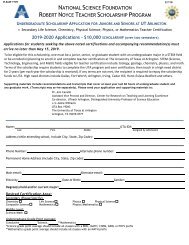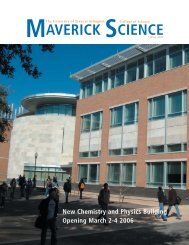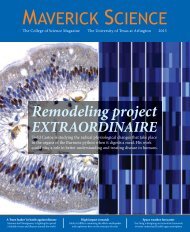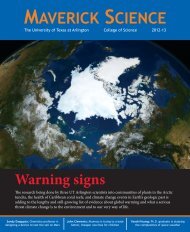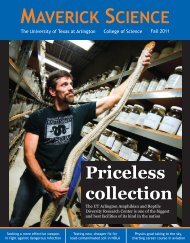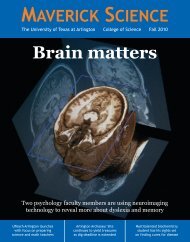Maverick Science mag 2013-14
Create successful ePaper yourself
Turn your PDF publications into a flip-book with our unique Google optimized e-Paper software.
Immuno-histochemical staining showing the distribution of MLL1 along the line of blood vessels<br />
(basement membrane) in the core of tumor tissue. CD31 is a well-known marker for angiogenesis.<br />
DAPI staining shows the nucleus. I<strong>mag</strong>e courtesy of Subhrangsu Mandal.<br />
MLL family of chromatin-modifying enzymes is a<br />
major player in the proliferation of tumor cells, angiogenesis<br />
and hypoxia signaling and antisensemediated<br />
gene targeting to MLL led to a<br />
suppression of tumor growth. This work revealed<br />
a novel epigenetic mechanism of tumor cell signaling.<br />
MLLs are novel targets for cancer therapy.”<br />
Mandal hopes that this research will eventually<br />
provide a new paradigm in antisense therapy and<br />
the discovery of new epigenetic medicines.<br />
In 2001, after over a decade of work,<br />
scientists successfully completed the<br />
first-ever “map” of the human<br />
genome, the complete set of genetic<br />
information for humans. This has<br />
opened the door for scientific exploration<br />
of subtle genetic influences on<br />
many common diseases.<br />
Another of Mandal’s current projects involves<br />
non-coding RNAs and their roles in epigenetics and<br />
disease. RNA is ribonucleic acid, a family of large<br />
biological molecules that perform many important<br />
roles in the coding, decoding, regulation, and expression<br />
of genes. RNA joins with DNA to form nucleic<br />
acids, which are essential for all known forms<br />
of life. An epigenome is a layer of biochemical reactions<br />
that turns genes on and off. It consists of<br />
chemical compounds that modify the genome and<br />
tell it how to behave.<br />
“The human genome sequencing founded an<br />
important milestone in today’s functional genomics<br />
world and fueled biomedical research by providing<br />
detailed nucleotide sequence information for protein<br />
coding genes present in humans,” Mandal said.<br />
“This helped in understanding the function of various<br />
human genes, their transcriptional regulatory<br />
network and roles in human diseases.”<br />
It was found that only a tiny percentage of the<br />
human genome encodes functional protein coding<br />
genes, with the rest considered to be mostly nonfunctional,<br />
or “junk DNA”. Subsequent studies suggested<br />
that more than 80 percent of the genome<br />
contains functional DNA elements that do not code<br />
for proteins. These non-coding sequences include<br />
DNA elements and sequences which code for transcripts<br />
that are never translated into proteins.<br />
These transcripts that are coded by the genome,<br />
transcribed into RNA, but are not translated into<br />
proteins are called non-coding RNAs (ncRNAs).<br />
“Studies show that non-coding RNAs are critical<br />
players in gene regulation, maintenance of genomic<br />
integrity, cell differentiation, and development and<br />
they are misregulated in various human diseases,”<br />
Mandal said.<br />
Mandal and his students are working with several<br />
non-coding RNAs, studying their roles in chromatin<br />
organization, gene regulation and diseases<br />
while trying to identify novel ncRNAs. One is called<br />
HOTAIR (for HOX antisense intergenic RNA),<br />
which is located on chromosome 12. Studies from<br />
Mandal’s lab have shown that HOTAIR is a key regulator<br />
in gene silencing, interacting with various<br />
gene silencing machineries and recruiting them to<br />
the target gene.<br />
“HOTAIR is overexpressed in breast cancer and<br />
it is transcriptionally induced upon exposure estradiol<br />
and expression is critical for cell viability and<br />
growth, tumor invasiveness and metastasis,” Mandal<br />
said. “Knockdown of HOTAIR expression resulted<br />
in breast cancer cell death, indicating its<br />
potential application in novel cancer therapy.”<br />
Arunoday Bhan, a fourth-year doctoral student<br />
in Mandal’s lab, is among those working on the<br />
project. He says he is excited to be taking part in research<br />
that could benefit millions of people.<br />
“The data generated from our research will not<br />
only aid in the formulation of therapies for cancer<br />
treatment but also could identify potential molecular<br />
targets that can be further developed as targets<br />
for therapeutic drugs or as prognostic markers for<br />
the identification of cancer at an early stage,” Bhan<br />
said. “It makes me proud that I am contributing towards<br />
the detailed understanding of the cancer<br />
epigenome that in the future might save people’s<br />
lives, or at least lengthen their life spans. I feel humbled<br />
by the fact that the research carried out in our<br />
lab would serve the community and society as a<br />
whole.”<br />
Paromita Deb, a second-year doctoral student,<br />
is also part of the project, studying non-coding<br />
RNAs and homeobox genes, which are a large family<br />
of similar genes that direct the formation of<br />
many body structures during early embryonic development.<br />
“Homeobox genes are involved in developmentrelated<br />
diseases and therefore, diagnosis of these<br />
genes could be important to therapy,” Deb said.<br />
“Dr. Mandal's innovative ideas have helped me sail<br />
through a sea of experimental hardships. He has<br />
always motivated me to work toward my goals.”<br />
Mandal says it is an exciting time to be involved<br />
in research which is showing how human genes<br />
function and which could lead to breakthroughs in<br />
methods of disease treatment and prevention.<br />
“Biochemical and biomedical research has<br />
reached a special stage, the ‘post genomic and<br />
epigenomic era’,” he said. “The human genome has<br />
been sequenced and now epigenomes are being<br />
discovered. Recent projects discovered that ‘junk<br />
DNA’ in the human genome is not really junk at all.<br />
In fact, it is code for many non-coding RNA that<br />
control the functionality of the whole genome.<br />
These provide much deeper insight about how the<br />
human genome is packaged, read and transcribed<br />
into RNA and translated into protein.”<br />
A<br />
nother of Mandal’s ongoing<br />
projects involves assessing<br />
how various chemicals<br />
found in the environment<br />
can disrupt the ability of the<br />
body’s endocrine system to<br />
function properly. The endocrine<br />
system is a collection<br />
of glands that secrete<br />
chemical messages, called hormones, to organs<br />
throughout the body.<br />
“Almost everything in your body is controlled<br />
by hormones,” Mandal said. “Hormones control<br />
26 <strong>Maverick</strong> <strong>Science</strong> <strong>2013</strong>-<strong>14</strong>



